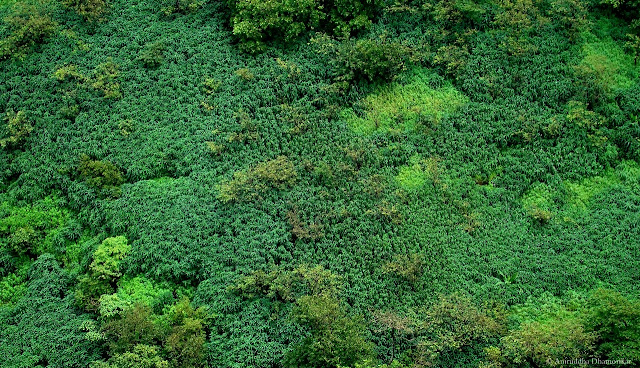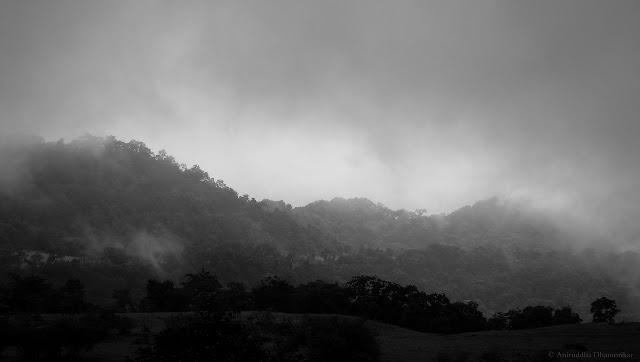This is the finale of the Saga (!) of the expedition we led to
Manikgad in August, and came home defeated but satisfied with the findings. In order to achieve what was unachievable three weeks ago has now been dealt with – we successfully trekked through the adversaries Manikgad cast at us, and climbed with all might and glory that I could gather after hauling my mass up the hills – to where the throne lay empty. It was a long and arduous trek, mainly because the paths were unused and many lead away from the fort. And let’s just not get to the weather for a change.
In summary, the weather was clear, hot and humid for a few hours while we trekked through the pits of the mountains. There was not a single puff of air and the humidity was very high. Yet life here was blooming in every nook and corner. Once we reached the plateau region of the mountain – a step nearer to the fort – the weather changed, and it began to rain. It rained heavily for a while and reduced to a little spray in the air. This lasted until we reached back to the base.
Since Manikgad is not new to you, let’s begin our journey as we quickly paced through and out of the woods, with me lagging behind trying to keep an eye out for anything that moved. We did not see much in these parts, surprisingly, for reasons I don’t know. It was a perfect day for insects and reptiles to bask under the monsoon sun, but it may have been a little late in the morning. The route was astonishing. We crossed a few little streams, sank our feet in mud, and made our way through a dense patch of Strobillanthes callosus. It was through this:
 |
| The greens of Manikgad |
These Karvy plants may look small, but they towered over six feet, and their stems were multiple – a mesh hidden beneath the large crenate leaves. Treading through this was no fun, but it was good adventure nonetheless. We heaved and sought a breath of fresh air. But we were still a while from the destination. When the Karvy finally gave way for the distinct moist deciduous forests with tall trees and a little air under their leaves, we sighed. It was only a hike of twenty minutes from here until we came to a clearing, and flushed a Carpenter Bee buzzing on the ground. There was also a large bag of sticks in the nearby thicket:
 |
| Bagworm taking a nap |
This bag, rather sleeping bag, was made by a caterpillar commonly called a Bagworm, and the adult is called as Bagworm Moth. Several families in the superfamily Tineoidea make such protective structures around them. This one probably belongs to the family Psychidae. The sticks are carefully chosen to match the height and girth of all the other sticks, then the caterpillar weaves silken threads between and under it that holds the sticks together. It then lives inside it, only protruding the head to feed and three appendages to navigate. It also pupates inside and the adult flies out after completing metamorphosis.
We were now beginning to reenter the forests, where we would tarry again through Karvy’s and other large sprawling trees holding onto the large pitch black boulders the size of a hundred me’s. But before it, there was a spectacle to behold:
 |
| A spectacle in monochrome |
The lush green lawns – trimmed and maintained with perfection by nature, as well as trees that rolled over and under the hills in the distance were glistening in the sun. As if the forests were on fire, the clouds rose like smoke from under the valleys and passed over the meadows seamlessly. I could have stayed here for days and weeks, and would have tried to run into those thick water-laden clouds had I not had the end in sight – that was the fort. And it is here that I happened upon something really tiny – a fly:
 |
| Beetle-backed Fly, family Celyphidae |
This is the Beetle-backed Fly that I’ve been talking about. Although I’m least satisfied with this photograph, it is just too tiny for my camera, and it does not do the justice to the beauty of this creature. It resembles a beetle because of the elytra-like structure over its abdomen, but it is not the hardened wings that form this structure (which in beetles is called elytra), it is the scutellum – a tiny part between the thorax and the abdomen of insects – that spreads out over the wings. It might seem to block the wings of the fly – but it is an extremely swift flier.
We also came across a little spectacle amidst the greenery – a gang of male Common Indian Crows hanging out on a dried-out Heliotropium indicum plant:
 |
| Euploea core sipping on a dried Heliotropium indicum |
They weren’t arguing among themselves, but drinking merrily to the fullest. Heliotropium indicum is the place to hang out if you’re a Danaine. This plant, when it dries, releases pyrollidizine alkaloids which the Danaines use as precursors to danaidone – a poisonous compound which is passed onto the eggs after mating takes place. It was a sight to behold, and it was even more interesting to watch when we knew the reason for their attraction to this only dead, shrunken shrub amidst the bustling greens around.
Now we were passing again into the deep shadows of the trees, and here it was not empty of life, for there were several mollusks as well as a number of Hemipteran bugs. One that caught my eye was a Leafhopper:
 |
| Nephotettix virescens |
It is, in all probability,
Nephotettix virescens – a widespread, common leafhopper in the family Cicadellidae. It is a common bug attracted to lights at nights.
N. virescens is considered a pest on rice crops. This was on a Karvy leaf, in a place that looked like this:
 |
| Tall Karvy's and Manikgad in the distance |
Looming above our heads was one of the shoulders of Manikgad – it wasn’t as far as we thought, but we were wrong! After entering another lap of Karvy’s, it disorientated our guide and we were lost again. Fortunately it was not for long, and we were back on the trail that ultimately leads us to the plateau of the fort. This plateau was teeming with life. All the insects that were already present on this highest point of the mountain were probably hill-topping.
A beetle fond of munching on flowers – a Blister Beetle in the family Meloidae was very common:
 |
| An unidentified Blister Beetle, family Meloidae |
This fellow is different from the one we saw in the last visit to Manikgad. This fellow and a hundred of his kind were feeding on flowers as well as looking for a mate. It is interesting to note that the previous Blister Beetle,
Mylabris pustula, was found on a lower elevation (around 1000 feet), and the elevation we were at (about 1800 feet) was dominated by the above photographed beetle. I’m still unclear of its identity, but there definitely must be some hierarchy amongst different Blister Beetles when it comes to choosing a niche, as it exists for many other animals.
A little ahead was a water tank – a reservoir common throughout the forts in India. These act as an excellent habitat for aquatic insects including Odonates, as well as frogs that feed on them:
 |
| Indirana sp. |
This frog is Indirana sp., an interesting frog fond of water but will rather stay close to it than in it. This reservoir was amidst the tall grass over the rolling mountains:
 |
| The Rolling Mountains |
The different colours belong to different species, the bright yellowish green are the grasses, with the bluish greens of the Karvy, and the brownish greens mushrooming down below are the several species of trees. At the top there was no fort actually, but very few ruins, such as this gate:
 |
| Ruins of Manikgad |
And a few stony walls that now hold the weight of all the living things that grew hereafter the emperor. There were also little pools of water teeming with life – from budding Pogostemon sp, an aquatic herb some of which are endemic to the Sahyadris. And while exploring these pools, I found a dragonfly that met with a fatal accident:
 |
| Annax immaculifrons that met with an accident |
This Blue Darner female must have lost her orientation in the heavy vortex of the wind atop the fort and slammed into the rock – hence the damage to the head. Her abdomen was badly fractured too, and there were ants already attracted to her injuries.
We were exploring every corner of the flat surface. The clouds were building up in force in the mean time. Soon it was raining again. We began our hike down, and reached the point where we had to turn back last time. Here a dragonfly sat patiently, probably awaiting the return of the sun, which never did come:
 |
| Tramea limbata |
It is Black Marsh Trotter, Tramea limbata. They are fond of a varied habitats – of tall grasses near marshes or clear streams in the meadows. T. limbata never swarms, but they might participate in other dragonfly swarms.
A few yards from this dragonfly’s perch was a gateway in the forests with still air down below, but the scene was completely changed. A veil of clouds was cast upon the otherwise hot and humid forests. It was cool too – a drastic change from the morning:
 |
| The Misty Forests |
We happily galloped our way down the mountains, singing and laughing like a bunch of merry dwarves. After crossing some extremely slippery rocks, our feet touched the soft mud of the bottom. We had achieved our aim.
 |
| Sesamum orientale |
Thank you for your patience through reading my blabbering blog. I scaled the Mahuli Fort yesterday, and plan to write about it next weekend. I hope to finish one last trek in the last weekend of the last month of monsoon. The next month will see the beginning of the Post-Monsoon Expeditions/Walks through some other parts of the northern Western Ghats. Keep checking for more before Summer takes over!
It is a joy to read your blog. No patience is required. I wish I still had the legs of my youth, I would trek like you do. My hill climbing days are over. It is good to travel them through your well written words and pictures.
ReplyDeleteNo patience required. Joy to read you appreciating the nature and capturing the nature so well.
ReplyDeleteDas sind Raphael und YvonneSeptember 21, 2011 at 5:10 PM
Really interesting Blog to read! Your pictures make it easy to follow your travels..
ReplyDeleteBeautiful landscapes and animal shots!
Thank you John, Purav and Yvonaut for your kind comments!
ReplyDeleteHi,
ReplyDeleteWhat I really like about your blog is that other than being a pleasant read, it is highly informative. It has become a reference guide for me since it has some hard-to-find factual information.
On this note, I have a query for you:
How did you know that the common crows on the Heliotropium were males? I am not aware of any sexual dimorphism in the common crows.
Thank you for those kinds words, Yashada! Regarding your query, it is males (mostly if not always, as has been observed), that present the females with this gift so to say, when they pass their sperms.
ReplyDeleteThat Celyphidae is stunning! Such an amazing family of flies!
ReplyDeleteBeautiful. Keep writing :)
ReplyDelete